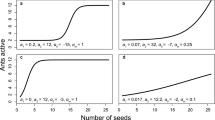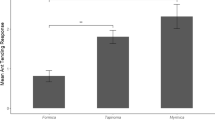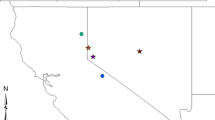Summary
We examine how cost and benefit components of resource profitability affect recruitment in the giant tropical ant, Paraponera clavata. To vary resource profitability, we changed the quantity of artificial nectar baits presented to foragers and the distance of nectar baits from the nest. Both distance to and amount of resource affected quantitative aspects of recruitment. At increased distances foragers were less likely to recruit, and fewer workers were recruited to the resource area. The amount of nectar affected the tendency of foragers to recruit, but had no effect on the number of ants recruited. Variation in resource distance was also associated with qualitative changes in recruitment strategy. Foragers at distant sites recruited from the canopy rather than from the nest, and often transferred nectar to other workers for transport to the nest. Nectar transfer and extra-nidal recruitment significantly reduced the time required for resource collection. It may also have increased the ability of workers to specialize in specific foraging tasks. A portion of the colony's foraging force specialized spatially by remaining in distant foraging areas without returning to the nest. The flexible recruitment system of P. clavata increases colonial net energetic gain rates by concentrating foraging effort on resources yielding the highest net energetic rewards, and increases the competitive abilities of individual colonies at resource sites by decreasing collection times.
Similar content being viewed by others
References
Baird CJ (1986) Complex interactions among nectivorous insects and hummingbirds at Heliconia imbricata flowers. PhD Dissertation, Univ California, Berkeley
Breed MD, Bennett B (1985) Mass recruitment to nectar sources in Paraponera clavata: a field study. Insectes Sociaux 32:198–208
Breed MD, Harrison JF (1988a) Individual odor trails in the giant tropical ant, Paraponera clavata. Insectes Sociaux 34:222–226
Breed MD, Harrison JF (1988b) Worker size, ovary development and division of labor in the giant tropical ant, Paraponera clavata (Hymenoptera: Formicidae). J Kansas Entomol Soc 61:285–290
Breed MD, Fewell JH, Moore AJ, Williams KR (1987) Graded recruitment in a ponerine ant. Behav Ecol Sociobiol 20:407–411
Breed MD, Stiller TM, Fewell JH, Harrison JF (1991) Territoriality and nestmate discrimination in the giant tropical ant, Paraponera clavata. Biotropica 23:301–306
Cammaerts MC (1977) Recruitment d'ouvrières vers une source d'eau pure ou sucrée chez la fourmi Myrmica rubra L. (Formicidae). Biol Behav 2:287–308
Chadab R, Rettenmeyer CW (1975) Mass recruitment by army ants. Science 188:1124–1125
Crawford DL, Rissing S (1983) Regulation of recruitment by individual scouts in Formica oreas Wheeler (Hymenoptera, Formicidae). Insectes Sociaux 30:177–183
Davidson DW (1978) Experimental tests of the optimal diets in two social insects. Behav Ecol Sociobiol 4:35–41
Fewell JH (1988) Energetic and time costs of foraging in western harvester ants, Pogonomyrmex occidentalis. Behav Ecol Sociobiol 22:401–408
Fewell JH (1990) Directional fidelity as a foraging constraint in the western harvester ant, Pogonomyrmex occidentalis. Oecologia 82:45–51
Fresneau D (1985) Individual foraging and path fidelity in a Ponerine ant. Insectes Sociaux 32:109–116
Hangartner W (1969) Structure and variability of the individual odor trail in Solenopsis geminata Fabr. (Hymenoptera, Formicidae). Z Vergl Physiologie 62:111–120
Harrison JF, Fewell JH, Stiller TM, Breed MD (1989) Effects of experience on use of orientation cues in the giant tropical ant. Anim Behav 37:869–870
Heinrich B (1975) Energetics of pollination. Ann Rev Ecol Syst 6:139–170
Heinrich B (1979) Bumblebee economics. Harvard University Press, Cambridge, MA
Hölldobler B (1976) Recruitment behavior, home range orientation and territoriality in the harvester ants, Pogonomyrmex. Behav Ecol Sociobiol 1:3–44
Hölldobler B (1985) Liquid food transmission and antennation signals in ponerine ants. Israel J Entomol 19:89–99
Hölldobler B, Möglich M (1980) The foraging system of Pheidole militicida (Hymenoptera: Formicidae). Insectes Sociaux 27:237–264
Hölldobler B, Wilson EO (1990) The ants. Harvard University Press, Cambridge, MA
Hubbell SP, Johnson LK, Stanislav E, Wilson B (1980) Foraging by bucket-brigade in leaf-cutter ants. Biotropica 12:210–213
Jaffe K, Howse PE (1979) The mass recruitment system of the leaf cutting ant, Atta cephalotes (L.). Anim Behav 27:930–939
Lighton JRB, Feener DH (1989) Water loss rate and cuticular permeability in foragers of the desert ant, Pogonomyrmex rugosus. Physiol Zool 62:1232–1256
Lighton JRB, Bartholomew GA, Feener DH (1987) Energetics of locomotion and a model of the energy cost of foraging in the leaf-cutting ant Atta colombica Guer. Physiol Zool 60:524–537
Moffett MW (1986) Behavior of the group-predatory ant Proatta butteli (Hymenoptera: Formicidae) an old world relative of the attine ants. Insectes Sociaux 33:444–457
Nielsen MG (1990) Energy investment and rewards in foraging by Messor capitatus (Latrielle). In: Veeresh GK, Mallik B, Viraktamath CA (eds) Social insects and the environment. Proc 12 Int Congr IUSSI. Oxford & IBH Publ, New Delhi
Nonacs P, Dill LM (1990) Mortality risk versus food quality tradeoffs in a common currency: ant patch preferences. Ecology 71:1886–1892
Oster GF, Wilson EO (1978) Caste and ecology in the social insects. Princeton University Press, Princeton
Otis GW, Winston ML, Taylor OR Jr. (1981) Engorgement and dispersal of Africanized honeybee swarms. J Apic Res 20:3–12
Rosengren R (1971) Route fidelity, visual memory and recruitment behavior in foraging wood ants of the genus Formica (Hymenoptera: Formicidae). Acta Zool Fenn 133:3–106
Schmid-Hempel P, Kacelnik A, Houston AI (1985) Honeybees maximize efficiency by not filling their crop. Behav Ecol Sociobiol 17:61–66
Schoener TW (1971) Theory of feeding strategies. Ann Rev Ecol Syst 2:369–404
Seeley TD (1986) Social foraging by honeybees: how colonies allocate foragers among patches of flowers. Behav Ecol Sociobiol 19:343–354
Seeley TD, Visscher PK (1988) Assessing the benefits of cooperation in honeybee foraging: search costs, forage quality, and competitive ability. Behav Ecol Sociobiol 22:229–237
Stephens DW, Krebs JR (1986) Foraging theory. Princeton University Press, Princeton
Szlep LR, Jacobi T (1967) The mechanism of recruitment to mass foraging in colonies of Monomorium venustum Smith, M. subopacum ssp. phoenicium Em., Tapinoma israelis For. and T. simothi v. phoenicium Em. Insectes Sociaux 14:25–40
Szlep-Fessel R (1970) The regulatory mechanism in mass foraging and the recruitment of soldiers in Pheidole. Insectes Sociaux 27:233–244
Taylor F (1977) Foraging behavior of ants: experiments with two species of Myrmecine ants. Behav Ecol Sociobiol 2:147–167
Taylor F (1978) Foraging behavior of ants: theoretical considerations. J Theor Biol 71:541–565
Traniello JFA (1977) Recruitment behavior, orientation, and the organization of foraging in the carpenter ant Camponotus pennsylvanicus De Geer (Hymenoptera Formicidae). Behav Ecol Sociobiol 2:61–79
Traniello JFA (1989) Foraging strategies of ants. Ann Rev Entomol 34:191–210
Traniello JFA, Fujita MS, Bowen RV (1984) Ant foraging behavior: ambient temperature influences prey selection. Behav Ecol Sociobiol 15:65–68
Verhaeghe JC (1982) Food recruitment in Tetramorium impurum (Hymenoptera: Formicidae). Insectes Sociaux 29:67–85
Wehner R, Harkness RD, Schmid-Hempel P (1983) Foraging strategies in individually searching ants Cataglyphis bicolor (Hymenoptera: Formicidae). In: Lindauer M (ed) Information processing in animals 1. Fischer, New York, pp 1–79
Wilson EO (1962) Chemical communication among workers of the fire ant Solenopsis saevissima (Fr. Smith). I. The organization of mass-foraging. Anim Behav 10:134–147
Wilson EO (1971) The insect societies. Harvard University Press, Cambridge, MA
Wolf TJ, Schmid-Hempel P, Ellington CP, Stevenson RD (1989) Physiological correlates of foraging efforts in honey-bees: oxygen consumption and nectar load. Funct Ecol 3:417–424
Author information
Authors and Affiliations
Rights and permissions
About this article
Cite this article
Fewell, J.H., Harrison, J.F., Stiller, T.M. et al. Distance effects on resource profitability and recruitment in the giant tropical ant, Paraponera clavata . Oecologia 92, 542–547 (1992). https://doi.org/10.1007/BF00317846
Received:
Accepted:
Issue Date:
DOI: https://doi.org/10.1007/BF00317846




